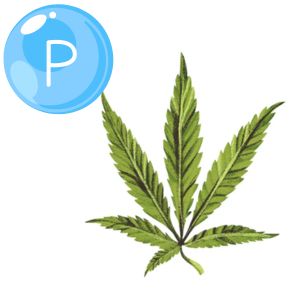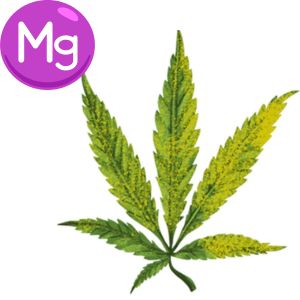
Mineral deficiencies can significantly affect plants, limiting their growth, development, and ability to efficiently carry out life processes. Here are some examples of mineral deficiencies that can occur in plants:
Nitrogen Deficiency
In the cultivation of marijuana, it is necessary to ensure an adequate amount of nitrogen at different stages of the plant's life. Too little nitrogen can lead to yellowing leaves, slowed growth, and even plant death. On the other hand, an excess of nitrogen can lead to excessive growth of the green parts of the plant at the expense of flowering and may cause other health problems for the plant.

Nitrogen deficiency in plants can be characterized by several different symptoms that may be visible on the leaves, stems, and the entire plant. Here are some typical symptoms of nitrogen deficiency:
- Yellowing of older leaves: One of the most common symptoms of nitrogen deficiency is the yellowing of older leaves, especially those located closer to the lower parts of the plant. The leaves may turn light green, then yellow, or even brown.
- Limited plant growth: Nitrogen deficiency can limit plant growth by reducing the production of proteins necessary for the construction of plant cells and tissues. As a result, plants may be shorter, weaker, and less developed.
- Delayed flowering and fruiting: Nitrogen deficiency can affect the reproductive processes of plants, leading to delayed flowering, fewer flowers or fruits, and poor fruit quality.
- Reduction in leaf coloration: Leaves may have less intense green coloration due to reduced chlorophyll production. As a result, the plants may appear pale or dull.
- Inhibition of root branching: Nitrogen deficiency can also affect root development, leading to inhibited growth and branching. This, in turn, can limit the plant's ability to absorb water and nutrients from the soil.
Co-occurrence with other deficiency symptoms: Sometimes nitrogen deficiency may occur simultaneously with the deficiency of other nutrients, complicating diagnosis. For example, nitrogen deficiency may coincide with iron deficiency, leading to interveinal chlorosis of leaves.
Phosphorus Deficiency

Phosphorus plays many important roles in the growth process of marijuana, including:
Root development: Phosphorus is essential for the production of energy, which the plant needs to develop a healthy root system. A strong root system allows the plant to effectively absorb water and nutrients from the soil.
Flowering: It is essential for the production and transport of energy within the plant, which is necessary for the production of flowers and seeds.
Stress resistance: Phosphorus helps the plant cope with environmental stress, such as drought or low temperatures, by regulating metabolic processes.
In marijuana cultivation, the right amount of phosphorus is crucial at various stages of the plant's life. During the vegetative phase, when the plant develops leaves and stems, it needs relatively smaller amounts of phosphorus than during the flowering phase, when the demand for this nutrient increases to support flower production.
Phosphorus deficiency can lead to delayed growth, reduced flowering efficiency, and overall plant weakness. On the other hand, excess phosphorus can lead to plant toxicity and negatively affect the availability of other nutrients.
Phosphorus deficiency in plants can manifest in various ways, but there are a few characteristic symptoms that can be observed.
Here are the most common symptoms of phosphorus deficiency:
- Growth inhibition: One of the first symptoms of phosphorus deficiency is usually growth inhibition of plants. They may appear smaller than normal, with shorter stems and less developed roots.
- Changes in leaf color: Leaves may take on abnormal colors, such as darker green or purplish hues. Chlorotic or purple spots may also appear on the leaves.
- Delayed flowering and fruiting: Phosphorus deficiency can also lead to delayed flowering of plants and fewer and lower-quality fruits.
- Red or purple stems and petioles: In some cases, particularly in plants from the tomato family, red or purple coloring of the stems and petioles may be observed.
- Reduced seed production: Plants may produce fewer seeds, and those that form may be smaller and less healthy.
- Root system disturbances: Phosphorus deficiency can limit root development, leading to weaker water and nutrient uptake from the soil.
- Increased susceptibility to environmental stress: Plants affected by phosphorus deficiency may be more prone to abiotic stresses, such as drought, diseases, or temperature changes.
Potassium Deficiency

Potassium deficiency in plants can manifest in various ways, but there are characteristic symptoms that can be observed. Here are the most common symptoms of potassium deficiency:
- Browning or dying of leaf edges: One of the most characteristic symptoms of potassium deficiency is browning or dying of the leaf edges, especially on older leaves. This process can progress gradually, starting from the edges and spreading towards the center of the leaf.
- Growth inhibition: Potassium deficiency can lead to growth inhibition of both shoots and roots. Plants may appear weaker and less developed.
- Reduced resistance to abiotic stresses: Plants affected by potassium deficiency may be more susceptible to environmental stresses, such as drought, diseases, or extreme temperatures.
- Reduced ability to regulate water: Potassium is essential for the regulation of water management in plants. Potassium deficiency can lead to disturbances in water and nutrient transport within the plant.
- Reduced ability to store energy: Potassium is necessary for the synthesis of energy compounds in plants. Potassium deficiency can lead to reduced energy production, affecting metabolic processes.
- Loss of firmness and turgor: Plants affected by potassium deficiency may exhibit a loss of firmness and turgor, resulting in soft and limp stems and leaves.
- Reduced tolerance to low temperatures: Potassium deficiency can make plants more sensitive to low temperatures, leading to tissue damage.
Magnesium Deficiency

Here are the most common symptoms of magnesium deficiency:
- Magnesium deficiency can occur for 4-6 weeks before any external symptoms appear.
- Older and middle leaves may show yellowing between the veins (interveinal chlorosis) and irregular rusty-brown spots.
- The plant may generally look unhealthy.
- Older leaves may dry out, curl, and fall off.
- This deficiency causes the areas between the veins of the leaves to turn yellow, leaving only the veins green. As the deficiency progresses, fan leaves may curl and develop brown spots.
- Increased susceptibility to stresses: Plants affected by magnesium deficiency may be more susceptible to environmental stresses, such as drought, extreme temperatures, or diseases.
If you are wondering if you have a magnesium excess, pay attention to whether the leaves are too dark green and the plant is starting to become stunted.
Calcium Deficiency

Here are the most common symptoms of calcium deficiency:
- Lower leaves may begin to twist and curl.
- Yellow-brown irregular spots may appear on the leaves and their edges.
- Flower development may slow down.
- Root tips may begin to die off.
- The plant may be stunted and produce smaller yields than expected.
- Calcium deficiency can affect the appearance of new leaves, causing them to curl or twist. Lack of calcium can also cause black spots to appear on both leaves and stems, resulting in underdeveloped roots.
Sulfur Deficiency

Sulfur deficiency is characterized by:
- Young leaves become light green to yellowish, and their growth slows.
- As sulfur deficiency persists, the veins of the leaves begin to yellow, and the leaves become less succulent.
- The tips of the leaves may become scorched, darkened, and bent downwards.
- When sulfur deficiency occurs in combination with a general nutrient deficiency, long purple streaks may appear along the length of the stem.
- The stems may also become woody.
- Bud formation becomes weak and slow.
- Sulfur deficiency can cause young leaves to become yellow or pale green, while older leaves acquire red-purple hues. Buds also tend to grow very slowly, which is certainly not desirable.
How can we help combat mineral deficiencies in plants?
Many fertilizers certainly contain the necessary ingredients for our plants, but it is CANNA that comes to the rescue in the form of fertilizers in its MONO line.
The Mono CANNA fertilizer line is a series of single-component fertilizers produced by CANNA, a significant manufacturer of fertilizers and plant products. These fertilizers are designed to provide plants with a single, specific nutrient in optimal concentration, allowing for precise control and correction of nutrient levels in the soil or growing medium.
Mono CANNA offers various single-component fertilizers that provide plants with the appropriate dose of individual nutrients, such as nitrogen (N), phosphorus (P), potassium (K), magnesium (Mg), sulfur (S), and others. Examples of fertilizers from the Mono CANNA series include Mono Calcium, Mono Magnesium, Mono Potassium, Mono Phosphorus, etc.
Mono CANNA single-component fertilizers are popular among plant growers because they allow for precise delivery of specific nutrients, enabling better control over the fertilization process and a quick response to the specific needs of the plants. Products from the Mono CANNA line are widely used in the cultivation of plants in industrial, commercial, and domestic settings, where precise fertilization is crucial for achieving high yields and plant quality.

